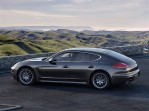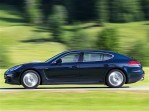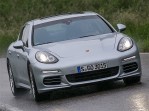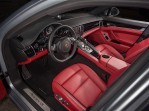Segment: Luxury
Production years: 2013, 2014, 2015, 2016
 17 Photos
17 PhotosThe Panamera 4S was more like a detuned Panamera Turbo rather than an upgraded Panamera 4, especially since it featured a twin-turbo engine under the hood.
Despite the slow and painful recovery from the world economic crisis, the Panamera found its way on the market. While the Europeans aimed for the diesel version, the rest of the world was busy with the gasoline-powered versions. The Panamera 4S was the middle ground between the mighty Turbo and the base model.
A major improvement for the Panamera S was the standard bi-xenon headlights and the option for full LED lamps. The daytime running lights were fitted with light-emitting diodes as standard. The revised front and rear bumpers brought a more aggressive look for the car. The bigger side-scoops in the apron were inspired by those installed on the 911 range. A wider rear windscreen was installed on the new tailgate.
Inside, the manufacturer installed the PCM (Porsche Communication Management) for the infotainment system. It supported Apple CarPlay connectivity, but its compatibility with Android phones was limited. The tachometer was mounted in the middle of the instrument cluster, with a round TFT display on its right side, where the navigation system could have been shown, as well as other on-board computer information.
The biggest change for the 2013 Panamera S was under the hood, where a twin-turbo 3.0-liter V6 engine was installed. It replaced the older 4.8-liter naturally aspirated unit. It was a win-win combination since it offered 20 hp more and it was more fuel-efficient. Unlike its predecessor, it was available exclusively with a 7-speed automatic (PDK – dual-clutch). The all-wheel-drive system was carried over, but the final drive was different to allow better fuel-efficiency. The Panamera 4S was available with a long wheelbase as well, for specific markets.
PORSCHE Panamera 4S (970) 2013, 2014, 2015, 2016
- 3.0 V6 7AT (420 HP)
PORSCHE Panamera 4S (970)
3.0 V6 7AT (420 HP)
ENGINE SPECS - 3.0 V6 7AT (420 HP) | |
|---|---|
| Cylinders: | V6 |
| Displacement: | 2997 cm3 |
| Power: | 308.9 KW @ 6000 RPM 420 HP @ 6000 RPM 414 BHP @ 6000 RPM |
| Torque: | 384 lb-ft @ 1750 RPM 520 Nm @ 1750 RPM |
| Fuel System: | Turbocharged Direct Injection |
| Fuel: | Gasoline |
PERFORMANCE SPECS | |
|---|---|
| Top Speed: | 178 mph (286 km/h) |
| Acceleration 0-62 Mph (0-100 kph): | 4.8 s |
TRANSMISSION SPECS | |
|---|---|
| Drive Type: | All Wheel Drive |
| Gearbox: | 7-speed automatic (PDK) |
BRAKES SPECS | |
|---|---|
| Front: | Ventilated Discs |
| Rear: | Ventilated Discs |
TIRES SPECS | |
|---|---|
| Tire Size: | 245/50R18 || 275/45R18 |
DIMENSIONS | |
|---|---|
| Length: | 197.4 in (5014 mm) |
| Width: | 76 in (1930 mm) |
| Height: | 55.8 in (1417 mm) |
| Front/rear Track: | 65.3/65.4 in (1,659/1,661 mm) |
| Wheelbase: | 115 in (2921 mm) |
| Ground Clearance: | 5.6 in (142 mm) |
| Cargo Volume: | 15.7 cuFT (445 L) |
| Aerodynamics (Cd): | 0.3 |
WEIGHT SPECS | |
|---|---|
| Unladen Weight: | 4123 lbs (1870 kg) |
| Gross Weight Limit: | 5401 lbs (2450 kg) |
FUEL ECONOMY (NEDC) | |
|---|---|
| City: | 19.3 mpg US (12.2 L/100Km) |
| Highway: | 32.7 mpg US (7.2 L/100Km) |
| Combined: | 26.4 mpg US (8.9 L/100Km) |
| CO2 Emissions: | 208 g/km |
















